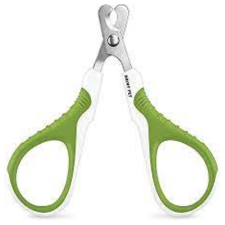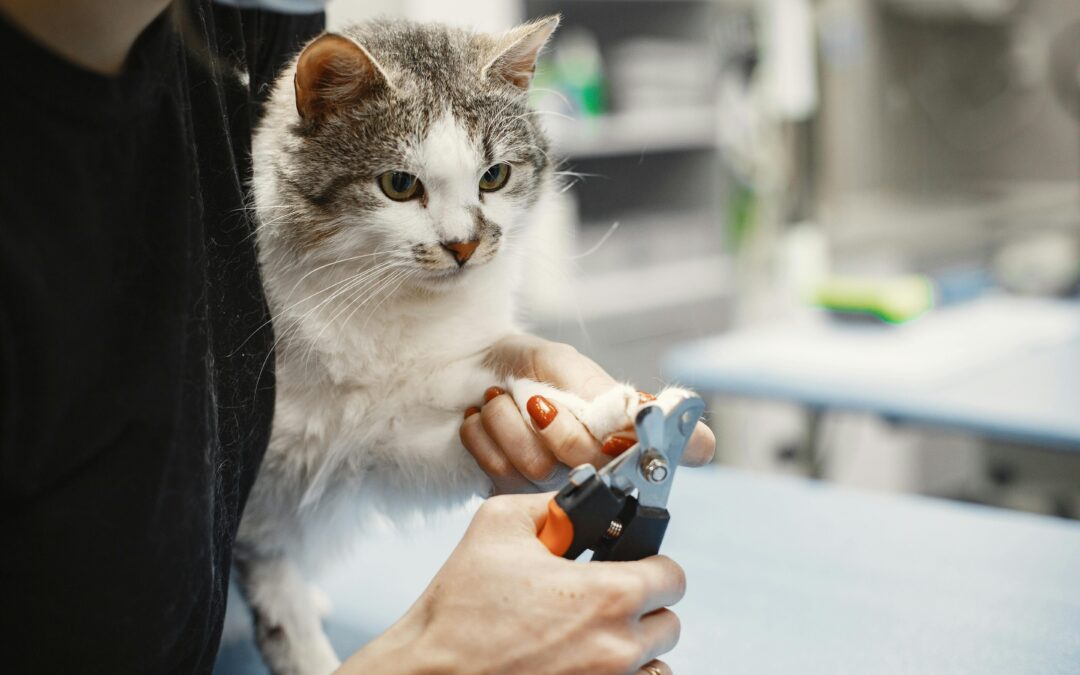We love our cats, from their fuzzy faces to their swishy tail tips. However, most cat guardians eventually deal with a big communication problem between them and their kitty friends: sharp nails that end up digging into skin or furniture. Cats need their nails to mark territory and defend themselves, but those little pokes while cuddling or playing can still be painful. While cat trees and scratchers can help save your favorite chair or bed, that doesn’t help save your skin from those stingy little cuts. One of the best ways we can help keep our kitties happy and our bodies scratch free is by helping them with routine nail trims.
Why do cats need their nails?
Big cats, feral cats, and housecats use their nails for territory marking, hunting, and protection. Cats release pheromones from their paws as they scratch. Outside, this lets other cats know that this area belongs to someone. Inside, our kitty friends have the same want, to mark your home as their home too. Being able to see their own mark helps build confidence in your cat that they own this territory. Scratching also lets them shed dead nail husks and stretch many important muscles.
Cat claws also help with hunting and protecting themselves if they need it. While housecats aren’t always on the hunt for their next meal, they do hunt play toys. Their sharp nails help to hold wiggly prey in their grasp. Even if your cat is always indoors and may not need their nails for protection, if anything happens and they get outside those nails could help them get back home in one piece.
We know that nails are important, but many guardians feel bad forcing their cats into nail trims or are afraid to hurt their kitty friends if they do it wrong. At Galaxy Cats, we want to keep our visits as low stress as possible for the kitties, which means we may not trim nails during your appointment. While some cats can have a vet clip them quickly with little to no stress, many other cats can get very worked up having strangers touch one of their most important body parts. If your cat is not too stressed, and there is time left in your appointment, we can try to do a nail trim demonstration with you. However, to keep cats from associating the vet with negative experiences we will tend to avoid nail trims if it seems like too much for your kitty. While it can be stressful, nail trimming is much healthier for cats than other anti-scratching alternatives. It will take time, but any cat can eventually be ok (or at least tolerate) getting their nails clipped.
What do you need?
Of course, the most important part is the clippers themselves. There are many types of trimmers on the market; from light up nail trimmers, small animal clippers, and nail grinders you may find you and your cat have an easier time with different options. You can check out popualr Amazon reccommended ones here. If this tends to be a stressful experience for your kitty, Feliway pheromone calming agents can make a big difference in how calm your kitty is!



An optional tool to help would be a clicker. Clickers are used in positive behavior training. Clicker training to have your cat be calmer for nail trims can take off a lot of stress from you and them. It also can help build a positive relationship between guardian and cat.
Where to start?

Look at those sharp little nails!
The most successful start happens before you bring the nail clippers in at all. Sitting with your kitty while they are calm and gently pressing, handling, and moving their paws will help them get used to your touch. If they start to pull away, that is them saying they are done for now. Reward them with a treat, play, or pets (this is where a clicker helps build association!) and try playing with their paws longer next time. Don’t be surprised if you stay on this step for a while. You want to build a relationship between your kitties’ paws and you to the point they are not too phased by your handling of their paws.
Once your cat is feeling calm with their paws being handled, while they are relaxing, bring out the clippers. If your cat is afraid of them on sight, let them sniff it and give a reward when they get near it or touch it. Having them associate clippers=good thing and they’ll be less likely to run and hide from them later!
When you and your furry friend are ready to try trimming, find a time when you and your kitty are calm and relaxing together. Bring out the clippers and just try one claw. If they are fine or at least not struggling to get away, try a second claw. For this first session, just try to get one paw done. Pushing too much at once can be stressful for many cats. If after one claw they are trying to run, are struggling, or just clearly unhappy it is ok to stop it there and try again later! Even getting one claw each day can help build confidence in your cat! End every session with a reward, you want to continue to build that trust that they are safe. Treats, play or love are great motivators! Take it slow, you know your cat best and it may be a very long time before you can get them still for all claws at once, and some cats will always be a little wiggly and may need two or more sessions to get all their paws done. The most important path to success is time, patience, and a calm attitude. Your kitty will look to you if they are unsure how to feel; the calmer and happier energy you put out, the less stressed your cat will feel!
Whichever you do choose, it is important to know how much nail should be trimmed at a time. Cats and many other animal nails have blood vessels known as a “quick”. The goal for trimming is to cut close to, but not into the quick. This is usually the part that most pet parents tend to be nervous about, as cutting into the quick can produce quite a bit of blood. To help stop bleeding if an accidental nick appears, have ready a clean cloth to apply pressure. You can also try a styptic powder (a product made to help quicks clot quick). The most important part is to stay calm, for you and your pet. While it can be scary for you, most quicks heal quickly and easily, if you notice something isn’t healing like you feel it should, contact your vet to set up an appointment.

We are always happy to demonstrate an example or give advice during your visit! Ask at your next appointment and we can help set you up for a purrfect trim!
If you are looking for some example trimmers, we sell small animal ones in clinic, but you can also check out this list of popular and highly rated clippers of all different shapes, sizes, and types!

